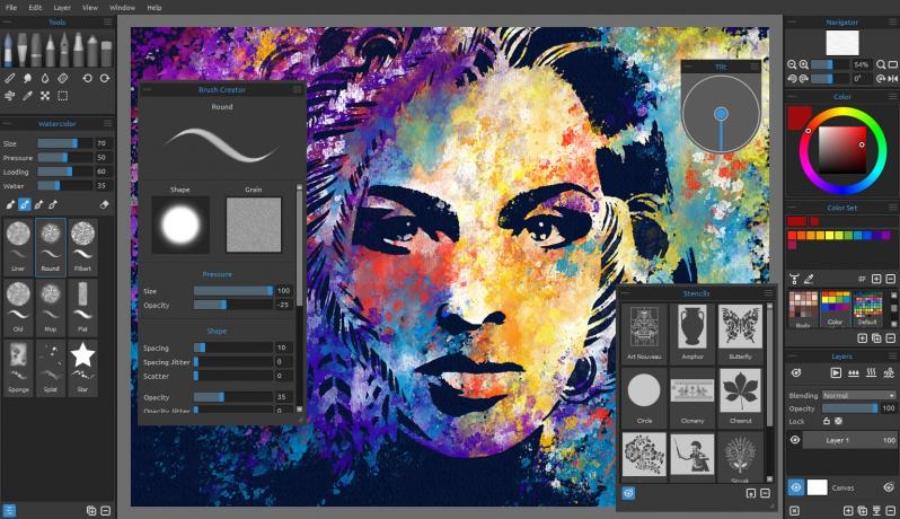Best Selling Products
Understanding Luminance and the Secret to Controlling Brightness in Photography
Nội dung
- 1. What is Luminance in photography?
- 2. The difference between luminance and brightness
- 3. Why is luminance important in photography?
- 4. How to control luminance in photography
- 4.1. Adjust the aperture
- 4.2. Shutter Speed
- 4.3. ISO
- 4.4. Using photo editing tools
- 4.5. Accurate light measurement
- 5. Notes on controlling luminance in photography
- 6. Conclusion
Luminance is an important factor in photography, determining the brightness and detail of a photo. Discover how to control luminance in photography through this article.

Luminance is an important concept in photography, directly affecting the way we perceive light and detail in a photo. Controlling luminance helps create sharper and more realistic photos. In the article below, sadesign will explain luminance in detail and provide useful tips for effectively controlling luminance in photography.
1. What is Luminance in photography?
In photography, luminance (also known as brightness) is a measure of how bright a photo or part of a photo is. The concept of luminance refers not only to brightness but also to how light is distributed across different parts of the photo. It affects our ability to perceive details and contrast in a photo.
.jpg)
Luminance is an important factor in creating a sense of depth and space in a photo, making the image come alive and have depth. In particular, luminance directly affects the feeling of natural light and the clarity of details in the scene. In image processing techniques, luminance is often expressed as a brightness value and is used to calibrate or optimize the light, to ensure that the photo achieves visual balance and harmony. Understanding and controlling luminance is one of the necessary skills for photographers to create high-quality works.
2. The difference between luminance and brightness
Although luminance and brightness both relate to light in photography, they are distinctly different. Brightness refers to how light or dark a photo or part of a photo appears in the RGB color space. Luminance, on the other hand, is a more technical factor that reflects how light is perceived by the human eye and how distinct colors are.
Luminance is a physical quantity that represents the amount of light emitted or reflected from a surface in a specific direction, measured in candela per square meter (cd/m²). It is an objective factor, depending on the physical properties of the light source or surface. Meanwhile, brightness is a subjective concept, related to how people perceive light. Brightness is affected by many factors such as environmental conditions, contrast, and the adaptability of the human eye. In other words, luminance is a specific measurement value, while brightness is a personal perception of the strength of light.
3. Why is luminance important in photography?
Luminance plays an important role in creating sharp, high-contrast images. A photo with good luminance will allow the viewer to easily recognize details from bright to dark areas without losing information. When luminance is not properly controlled, the photo can be overexposed or underexposed, losing detail and reducing image quality.
.jpg)
Luminance not only helps create depth and contrast but also highlights important details in the frame. In particular, precise control of luminance helps photographers convey emotions, stories and meanings of the work more effectively. In addition, in the post-processing process, understanding luminance also helps optimize light and color, ensuring that the final photo achieves high quality and attracts viewers.
In addition, luminance also affects the emotions that the photo brings. Properly adjusted lighting will help the photo have depth and balance, creating a delicate and pleasant work of art to look at.
4. How to control luminance in photography
To effectively control luminance in photography, photographers can apply the following techniques and tools:
4.1. Adjust the aperture
Aperture is an important factor in controlling the brightness and luminance of a photo. When you open the aperture wide (low f-number), you allow more light into the camera, increasing the brightness of the photo. The aperture, expressed in f-stops, determines how much light enters the camera sensor through the lens. When you close the aperture (increase the f-number), less light is let in, reducing the brightness of the photo and making it suitable for bright lighting conditions.
However, if the aperture is too wide, you may lose control over the depth of field, resulting in some areas of the image being blurred. Adjusting the aperture affects not only the brightness but also the depth of field, so the photographer needs to consider carefully to achieve the optimal results as desired.
Conversely, when the aperture is narrow (high f-number), you reduce the amount of light entering the camera and maintain a wider depth of field, making the details in the image sharp. Adjusting the aperture properly will help you control luminance and create more harmonious photos.
4.2. Shutter Speed
Shutter speed is also an important factor in controlling luminance in photography. Slow shutter speeds allow more light to hit the sensor over a longer period of time, increasing the brightness of the image. Slow shutter speeds allow more light to hit the sensor, allowing for shooting in low light or creating artistic motion blur effects. Shutter speed adjustments need to be made carefully, in conjunction with aperture and ISO, to achieve the optimal balance of light and produce a high-quality image.
.jpg)
On the contrary, fast shutter speed helps to capture clear movements, but at the same time reduces the brightness of the photo. Therefore, choosing a reasonable shutter speed is necessary to control luminance optimally.
4.3. ISO
ISO is how sensitive your camera sensor is to light. A high ISO will help you take photos in low light conditions while still maintaining brightness. However, a high ISO can also introduce noise into your photos, reducing detail and overall quality.
Increasing the ISO makes the sensor more sensitive to light, allowing for better low-light photography. However, increasing the ISO too much can lead to noise, which reduces image quality. Therefore, photographers need to carefully consider the need for brightness and image quality, and combine ISO with other factors such as aperture and shutter speed to achieve optimal results.
Adjusting the ISO to suit the lighting conditions and luminance requirements in the photo will help you get sharp and clear photos.
4.4. Using photo editing tools
Photo editing software like Adobe Lightroom, Photoshop, or Capture One have tools that give you detailed control over luminance. You can adjust the brightness of highlights, shadows, or even adjust the luminance of individual colors in your photo.
With these tools, you can easily enhance or reduce luminance in specific areas without losing detail in the photo. Operations like Dodge and Burn , Curves , Levels or Luminance Masking will help you fine-tune your photos perfectly.
4.5. Accurate light measurement
Accurate metering is the first and most important step in controlling luminance. Your camera has an exposure meter that helps you determine the level of light in your scene. There are three main metering modes: evaluative metering, center-weighted metering, and spot metering.
Choosing the right metering mode helps you control the light levels in your photo and avoid overexposure or loss of detail in dark areas.
5. Notes on controlling luminance in photography
In photography, controlling luminance plays a vital role in creating the quality and feel of a photo. To achieve optimal results, you need to pay attention to factors such as ambient light, camera settings, and post-processing capabilities.
.jpg)
Natural Light vs. Artificial Light : Natural light like sunlight creates rich luminance variation in the photo. Meanwhile, artificial light can be better controlled, making it easier to create the desired luminance effects.
Experiment and Adjust : There is no set formula when it comes to adjusting luminance. Experiment with different settings and adjust to your specific situation to find the luminance control that works best for your photo.
Luminance and color : Luminance not only affects brightness but also has a close relationship with the color in the photo. Make sure that when adjusting luminance, you also consider the change in color so that the photo does not look off-tone or too bright.
In post-production, luminance adjustments need to be done delicately to maintain detail and not lose the naturalness of the image. Ultimately, always keep in mind the artistic goal and the emotion you want to convey to control luminance most effectively.
6. Conclusion
Luminance is an essential element in photography, helping to create photos with moderate brightness and sharpness. Proper control of luminance helps you create photographic works that are not only aesthetically pleasing but also clearly demonstrate the sophistication and technique in every detail. By adjusting aperture, shutter speed, ISO, and using photo editing tools appropriately, you can effectively control luminance and create great photos.












































